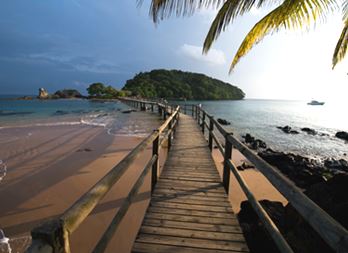| Pesquise em: |
|
Webmail |

Principe island
Comparing to Sao Tome, Príncipe island is the oldest, with the oldest rocks dating back 31 million years and São Tomé, 14 million years old. The islands are mountainous, with the highest peaks reaching to 2,024 meters on São Tomé (Pico de São Tomé) and 948 meters on Príncipe (Pico do Príncipe).None of the islands have been connected to mainland Africa.
The Tinhosas islands are two unvegetated rocky islets lying 22 km south of Príncipe. Tinhosa Grande has an area of 22 hectares, and reaches 56 meters elevation, and Tinhosa Pequena is 3 hectares in area and 65 meters elevation.
The island was uninhabited when discovered by the Portuguese and named "Príncipe" (Prince's island) in honor of Afonso, Prince of Portugal, his father's favorite. Subsequently, the north and centre of the island were made into plantations, most of them formed by Portuguese colonialists using slave labor. These concentrated initially on producing sugar and later on cocoa, becoming the world's greatest cocoa producer. Since independence, these plantations have largely reverted to forest.
Príncipe was the site where Einstein's Theory of Relativity was experimentally proved successful by Arthur Stanley Eddington and his team during the total solar eclipse of May 29, 1919.

Principe - The worl Biosphere Reserve (by UNESCO)
The reserve includes the entire land area of the Principe Island, its islets and a marine component, which in total comprise a wide biodiversity and geodiversity. There is also a natural park in São Tome island with wide biodiversity, in terms of habitats as well as native and endemic species internationally recognized and classified by the World Wide Fund for Nature (WWF) as one of the 200 most important eco-regions in terms of biodiversity and being also recognized as one of the 10 hostpots of most important reefs on the planet. As oceanic islands, the native biological wealth of the country is accentuated by its geographic isolation, containing several species and subspecies of endemic flora and fauna.
Accommodation in Principe Autonomous Region:
- BOM BOM ISLAND RESORT (High standard hotel)
- BELO MONTE HOTEL (Plantation Luxury hotel)
- Arca de Noe Guestouse
- Del Mata Guesthouse
- Palhota Guesthouse - Principe
- Mira Rio Guesthouse
- Roça Abade - Plantation guesthouse
- Ponta do Sol - Plantation guesthouse
